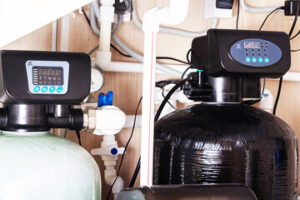What is Water Softening?
Water softening is a process that removes the hardness minerals calcium and magnesium from your water. It can help make your household cleaning supplies more effective, reduce scale buildup and save you money on your plumbing bills.
There are a few different ways to remove hardness from your water, but the most common is to use ion exchange resins. They come in the form of hundreds of tiny beads that attract the calcium and magnesium ions in your water.
Water softening is a common home improvement that makes it possible to remove hardness minerals such as calcium and magnesium from the water. This helps to eliminate buildup of scale and soap scum from pipes, showerheads and faucets. It also helps to keep your appliances and plumbing functioning longer, which reduces energy costs.
The water passes through an ion-exchange resin tank filled with hundreds of tiny beads. The hardness ions in the water (calcium and magnesium) bind to the resin, while the salt ions (sodium) are released. This process is known as ion exchange, and it transforms the hardness ions into sodium ions.
Another way to remove hardness from water is through reverse osmosis. It uses a semi-permeable membrane to remove hardness ions such as calcium and magnesium.
It is an expensive appliance, but it is effective in removing many different impurities from the water supply. However, it can have negative environmental impacts in the long run if used for a prolonged period of time.
One major environmental issue with ion-exchange water softeners is that they use a large amount of water to regenerate their media. This can add up to thousands of gallons per year!
This is an especially big problem in areas where there are already high concentrations of salt in the water due to road salt application, agricultural runoff and other sources. When the salt levels rise, it causes a number of freshwater animals and plants to die out.
In addition, it can also negatively impact local parks and gardens. This is because some plants are sensitive to the salt that water softeners discharge.
If you have a garden, consider using a salt-free system instead of traditional softeners. This way, you can avoid the harmful effects of sodium chloride discharge and improve your horticultural efforts.
Lastly, consider using a demand-initiated regeneration system on your softener. These systems only regenerate when the water flow through the resin tank has reached a certain volume.
These systems are more efficient than conventional salt-based water softeners, which use a lot of water to flush the system and recharge the resins. This means that they can save the environment a lot of water in the long run.
Water softening systems work based on the principle of ion exchange, which is a chemical reaction that replaces hardness minerals with sodium ions. As the water flows through the resin “bed” it replaces divalent calcium or magnesium ions (Ca2+ and Mg2+) with univalent sodium ions (Na+) or potassium ions (K+).
The process of water softening involves negatively charged resins that absorb and bind with the positively charged calcium and magnesium particles in the water. The displaced ions pass downward through the resins and out the softener drain; the water that is returned to the house has “soft” sodium instead of calcium or magnesium ions.
However, this process is not without its negative impact on the environment. Salt is the main product used in water softeners and, while it’s sourced from nature, its extraction is a major process that can have an environmental impact.
In addition, all water softeners must regenerate; this is a process that flushes the dissolved hardness minerals from the resins with a highly concentrated salt solution called brine. This is a time-consuming process that can waste a lot of water.
Regeneration can be a major drain on your water supply, especially if the regeneration cycle is set on a timer and happens more frequently than necessary. This means that you’ll have to pay for more water as it goes through the softener and then flushes it away.
